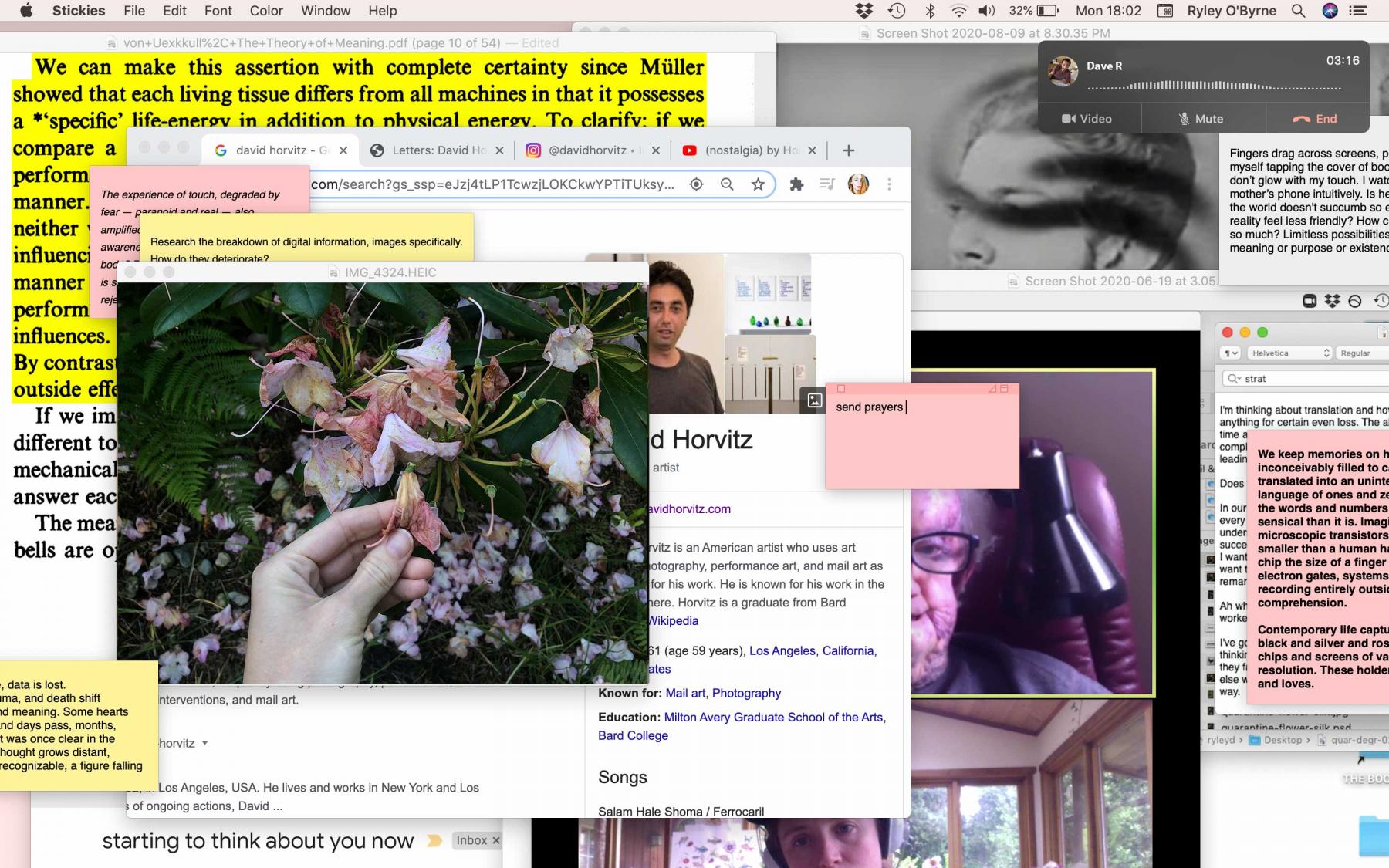
Time is slippery, expanding, and contracting simultaneously. Forward, back, forward, back, searching for balance. Micro-movements make a dance of the fall (like the dances we do on the sidewalk, keeping our distance). Mid-slip feels endless, somehow senseless, we have no idea where the ground is or when it will arrive. (In the meantime, maybe we grow wings?) Everything is expanding and contracting now — lungs, bravery, optimism.
—
The flowers came late this year. Laggard blooms, stamens tightly swaddled, all wrapped up in pink. I heard it again and again, the cruelest month, the cruelest month, as if no one could think of anything new to say of April. Now I’m sure that May was worse, then June, July — August was horrific.
You never know what form your blessings will take. Your curses too. I find myself saying this like a mantra, prayer, or cliché.
—
Back in spring, when limbs dripped in blossoms and discarded petals floated through the air, I paid artist David Horvitz one dollar to think about me for one minute.
Six weeks later — when the peonies had come and gone and I had completely forgotten about the dollar I’d sent — at 12:43 AM PDT he sent me an email with no body and the subject line starting to think about you now and then another, the minute is up.
I laughed when I saw the messages in my inbox the next morning and sent him an email telling him I liked the project, that it was smart and soft and funny. I asked him what he thought about when thinking about me. A faceless figure? My email address? Did he think of blood? Hands? Handles?
Of course, he didn’t respond.
—
We see the ones we love onscreen, as jagged portraits in otherworldly palettes. I take screenshot after screenshot of my computer glitching, faces fracturing, the breakdown of video calls.
—
The images keep coming and coming. Like chores, like sleep, like hunger. A buildup of digital information, the residue of our lives, thousands, tens of thousands of photos, all these words and emails and files. What will become of them? I decide to start the arduous process of purging the buildup, going through my computer and phone, trashing things I don't think I need. The act is euphoric and manic and the next day, I'm taken by doubt — how will I remember? What am I without this history?
I keep backups of backups, a shelf full of hard drives. Relics or some kind of proof. (Nana is in there somewhere, still laughing. How many files would it take to bring her back? Digital resuscitation.)
Our lives are becoming virtual. Her smile, my hand, this phone. I turn it off at night. But somewhere behind the glassy dark of the empty screen is my virtual self, active and lit — eyes open, chest rising and falling with some simulacrum of breath — by battery and chip.
I read a letter Horvitz wrote to curator Yann Chateigné describing his project, Nostalgia, named after artist Hollis Frampton’s 1971 video work. Frampton’s original piece documents the artist burning his photographs one by one on an element. Disconcertingly, the image being destroyed onscreen is not the one being described by the narrator, who instead details the photograph in the following shot. We hear of the future and see the past, while trying to remember the story of the present. In Horvitz’s version, images from his digital archives are projected in the gallery for one minute each, after which all copies of the file are deleted. He writes that the project will go on until every image is erased.
But they keep coming.
—
Finally, the height of summer arrives in an egomaniacal explosion of petals and pomp — obscene displays of beauty — birds and flowers, thirsty in the summer heat.
These days, everyone’s thirsty. Fixated on images scrolling and rolling. The origin of fixation is alchemical — the reduction of a volatile spirit or essence to a permanent bodily form. Yet we seem to prefer volatile spirit over bodily form, resigning ourselves to life lived in the interactivity of the void. Our existence is mediated and determined by mile upon mile of thread and feed. Square eyes glowing as we watch the world burn. Every reality is virtual.
(I think the irises would do the same. Dogwoods, rhododendrons, obviously the peonies. Undressing before the camera, posting shamelessly, judging too — like like like, unfollow. Birds flashing jewelled feathers, vying for adoration, our precious attention.)
—
I’ve thought about Horvitz so much more than he will ever think of me. Certainly more than I paid him for. What’s a minute worth? One dollar? Five? Twenty cents on minimum wage. And eight minutes? Value is as slippery as time.
—
Nearly six weeks later — when glowing sour cherries have been picked nearly clean from the bow, and once again I’ve forgotten about the artist and the email, everything squeezed from consciousness by the heat and hubris of summer — at 1:09 AM PDT he says i just think really hard trying to imagine you, whoever you are, wherever you are, not really visualizing, just knowing you exist!
—
I'm on an email list that’s mostly people asking for waves of divine love. Something akin to prayers.
In the past, I didn’t use words like prayer or blessing. Outside the context of contemplation or discussion, the specific vocabulary of religion felt off-limits or off-putting, maybe intimidating, sometimes illogical. Now it seems obvious.
Perhaps making art is an act of faith too, every gesture a prayer.
Do you ever think of the minute as a kind of prayer? I ask Horvitz, this time as a DM on Instagram.
Less than an hour later he responds: in a sense, yes.